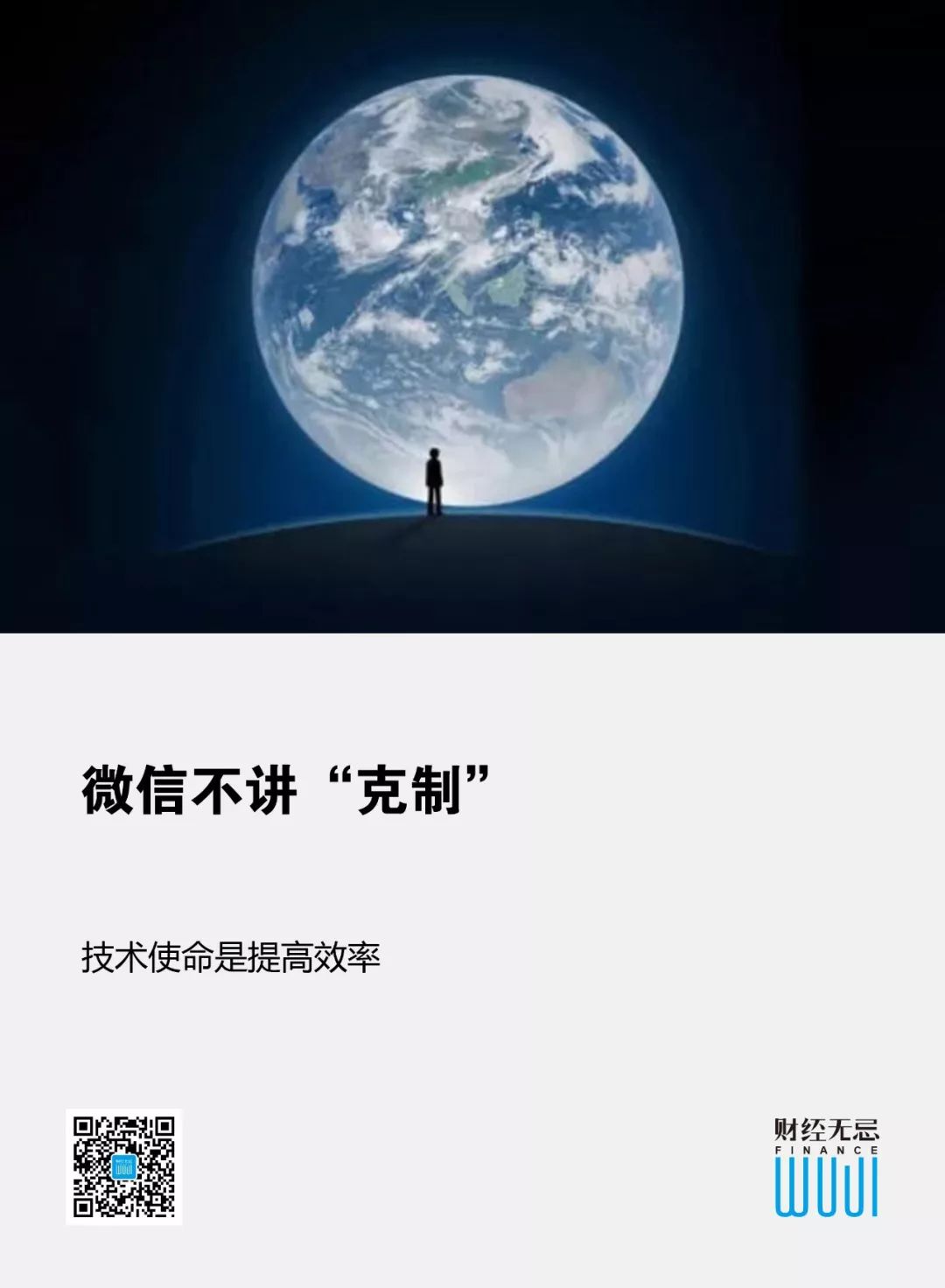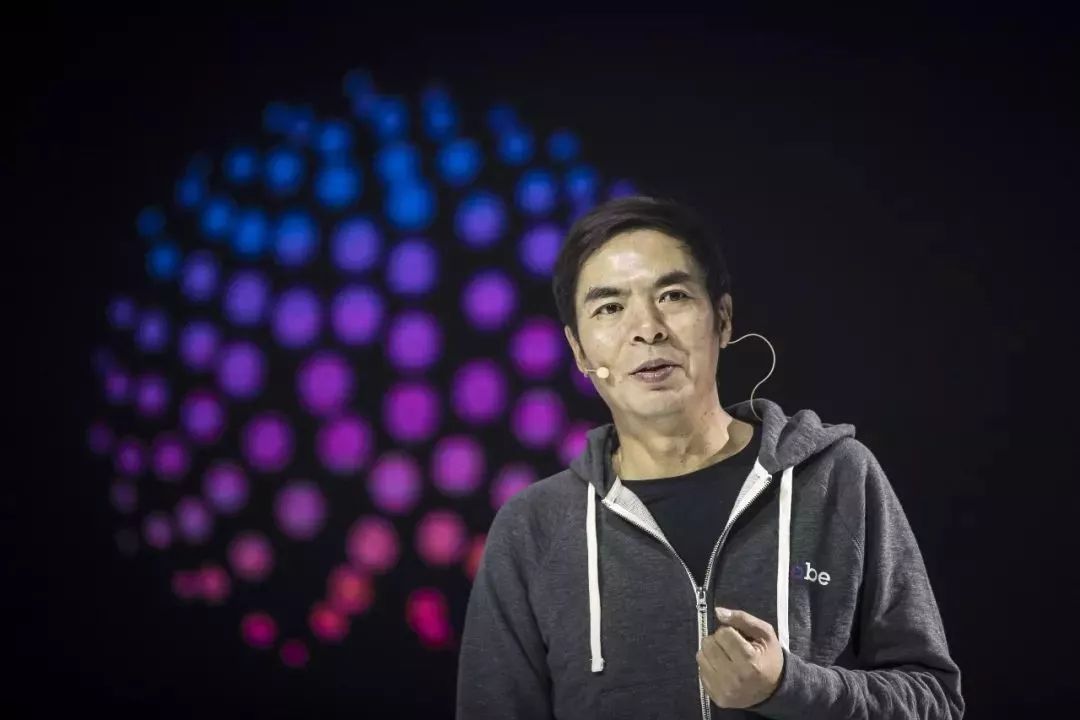Technical mission is to increase efficiency : Caijwj) , the author has no rust bowl.

On December 26, the failure of the WeChat public account system re-ignited the dialectical thinking between technology and efficiency.
Before that, on December 23, WeChat released an update for version 7.0.9.
Although the WeChat official description of the new features after this update only has an understatement of “can refer to the previous content”, netizens who are keen to explore still see the mystery from the huge update package.
After the vigorous “Find Differences” campaign, a series of changes such as the comment package function of the friends circle, the permission settings of chat friends, and the forwarding icon to distinguish the source of the article were immediately picked up. The emoticon comment function once caused a “fight of fighting” in the circle of friends, and the crazy discussion continued to many other social media.

This is not the first time WeChat’s update has detonated public opinion. Unlike the mobile phone QQ, which has an update rate of up to 13 times a year, WeChat’s more cautious attitude towards the new version has already unknowingly strengthened people’s “relevance “Mindset”, coupled with up to 1.1 billion monthly active users, is enough to keep the topic and heat behind every update.
Including this time, throughout 2019, WeChat only updated a total of 9 versions, of which the existence of 3 is more concise and clear-“solved some known problems.”
In today’s Internet industry, full of creativity and anxiety, such a speed of pushing new things is almost unimaginable. To a certain extent, Zhang Xiaolong and his products have indeed created a miracle: In this era of fast-growing things, the least change in microcredit has gathered the most users, and on this basis has achieved the greatest eternity. .
Of course, beyond that, about the kind of WeChatThis controversy has not disappeared.
01, WeChat is no longer restrained?
This time, the focus of the debate on opening emoji package comments is only one: “Is WeChat changed?”
Before that, the evaluation of WeChat’s product has always been very polarized:
People who like it believe that all aspects of this software reflect the ultimate in practicality, simple operation, stable performance, and aesthetic balance; those who don’t like it feel that this APP is simple in details, lacks user experience, And it is full of designers’ subjective will, and the feedback mechanism is even more messy.
Behind the contradictory evaluation, it is actually the embarrassing situation of this product-wechat with the world’s largest C-end user, whose design thinking is almost completely To B.
This is also the reason why Tencent, which has two major social products at the same time, has not fallen into the quagmire of internal consumption, imitating ICQ’s QQ and WeChat created to block kik. It ’s better to be more complementary. Between the two, QQ focuses on PC, personalization, young people, and entertainment scenes. WeChat is good at mobile, high efficiency, all ages, and instrumental socializing.

Compared with QQ’s aristocratic privileges, rich decorative colors, and extensive extension functions, “restraint” is the most frequently used word when people praise WeChat. Pony himself also said in an internal meeting that the WeChat team “keep A restrained mentality to do things. ”
As a devoted believer in Jobs ’minimalism, the chief disciple of Occam’s razor and young artist Zhang Xiaolong used the simplicity to the extreme when designing WeChat, which not only strictly restricted irrelevant expansion functions, but also from the source. Keep the interface streamlined and orderly.
As soon as the “shake a shake” feature came online, in the face of Pony’s concerns about plagiarism by competitors, the “cosmic first product manager” vowed: “unless he did nothing, If he added a little more, it would be beyond us. “
In the 2017 WeChat Open Course PRO version, the elites who spent 1500RMB to buy tickets to enter the Asian Games Stadium with the purpose of looking for business opportunities in the new era, listening to the “Father of WeChat” company “No” for a few hours:
-
Can’t push entry for users who haven’t run an applet
-
Can’t categorize, rank, recommend applets
-
You cannot add fans to the applet
-
Can’t push messages to applets
-
Can’t make applets into games
-
Can’t add search function
Also in that press conference, Zhang Xiaolong elaborated a design theory that is still somewhat “incompatible” even today:
“A good product should be used when people run out.”
This high profile has also become the theoretical basis for many people’s “Shang Zhongyong”. Looking back, it can be said that in the field of all-social products, WeChat is recognized as one of the best-looking platforms for “eating phase”-the strongest idealism, the least advertising and the least entertainment. WeChat, which has always maintained a “restraint” attitude towards traffic, rarely takes the initiative to solidify and train users.
In contrast, the expression package comment function, as the other two main social positions of Weibo and QQ’s iconic function, has long been familiar to many young netizens. In addition to being fun, the entertaining nature of the emoticons and the passing of time are also widely known. Adding such a lack of originality to the list of upgrades obviously does not fit the WeChat platform’s consistent maverick, low-key and serious style.
This is also the source of ideas such as “WeChat accommodates users”, “WeChat no longer restrains”, “WeChat entertainment to death”.
But is this really the case?
02, The original sin of the emoji
To understand this, we must first understand why the expression pack comment of the open circle of friends can cause such a huge controversy. Among them, what kind of expression pack that ignites the frenzy of the full network of buckets? presence?
Since Professor Scott Fallman of Carnegie Mellon University in the United States first used the symbol “:-)” in the computer science community in 1982, this brand-new information form has been used for almost 40 years. Immediately spread to the whole world.
Data shows that in the past 2018, nearly 900 million QQ users sent more than 318.7 billion emoticons a year, and more than 90% of users were keen to use emoticons in the chat process. Behind the enthusiastic emoji storm, in addition to being surprised by the many changes it has brought to the chat environment, people have always faced warnings about Neil Bozeman’s “entertainment to death”.

Whether the popularity of expression packs is directly related to entertainment to death, the point of view behind this is benevolent, but it is certain that a trend represented by this has not opened a brand-new era. On the contrary, they are just A node and microcosm of the existing “image age”.
The so-called “image age” is a view put forward by the German philosopher Heidegger in the 1930s. He predicted that visual culture in the future world will occupy an unprecedented dominant position in people’s daily life. On this basis, images will become the main way for people to understand the world around them.
The root cause of all this is the irreplaceable advantages of images as a media form. Compared with words, images carry a larger amount of information, more concentrated information, and more intuitive information presentation.
Today, Hai ’s predictions have become more or less a reality. Compared with Pablo Neruda ’s poems with emotions, expressions and pictures are becoming a new communication in the information age. The bridge of the generation crowd.
Study from American scholar L. Birdwhistle shows that nearly 75% of social meanings in modern society are transmitted by non-verbal symbols. Alberton Meregby, who specializes in non-verbal symbols, has also proposed a formula: the two communicating parties understand each other = intonation, speed of speech (38%) + expression, gesture (55%) + language content (7%).
From this perspective, the emergence of emoticons is actually an inevitable product of social interaction in an information explosion society.
In this era where the integrated components on the chip double every 18 months, the demand for information is also rising rapidly. On this basis, if a cat, a movie, an animation Screenshots can perfectly express your complex emotions along with details, so why bother to think about organizational language?
The plausible advantages mentioned above are exactly what the scholars of the Neil Bozeman and Frankfurt Schools worry most.
In the former’s understanding, “language is an abstraction of experience, and images are the concrete presentation of experience”, in other words: when you look at words, people think; when you look at pictures, this kind of thinking Just disappeared. In contrast, the latter worry more about the weaving and landscaping of one’s emotions during the long process of making and disseminating pictures.

For example, the same is chat plus emoticons, wavesZiman thinks that people will not use words to describe their thoughts and attitudes after seeing more emoticons, while another school thinks that if more emoticons are used, people will be addicted to the virtual ones created by expressions. “I” then lost his true personality.
For a long time, these reflections on contemporary communication have become the main source of emoticon “original sin” thinking.
03, WeChat does not talk about “restraint”
Excluding this layer of original sin thinking, the use of emoticons in social situations is actually beneficial. Therefore, the enthusiasm of a social media for emoticons cannot be simply equated with the tendency to entertain.
Let ’s talk about the pros and cons of running away with emoticons. WeChat is now actively opening a circle of emoticons to comment on whether it ’s “being charming” to users. This point is still questionable.
As mentioned earlier, when talking about WeChat, many people like to use the word “restraint” to describe it. However, in fact, little attention has been paid to the fact that this statement has disappeared within Tencent for some time.
In the WeChat night at the beginning of this year, in front of countless media, Zhang Xiaolong publicly stated: “WeChat is not restrained. There is no such restraint in our dictionary.”
For example, he said that WeChat never does festival operations or logo changes. Many people would say that WeChat is “restrained”, but this is not the result of restraint. “In essence, it is because WeChat has always followed a good design principle. Under the principle, there are both things that we don’t insist on and things that must be changed.”
Besides that, “restraint” or “dedication” is not satisfied with the user’s needs. These are more attributes that are just conceived by onlookers, and do not represent WeChat’s true philosophy.
On this, Zhang Xiaolong’s own design thinking about WeChat has always been clear: “efficiency”.
He has mentioned more than once in several press conferences that the mission of technology should be to improve efficiency.

Efficiency is what WeChat does everything possible to achieve. For example, you suddenly want to send a message to someone, but you ca n’t remember his name all of a sudden, and WeChat can provide a smarter association ability to help users find the information they want when there is a short circuit, which is what WeChat values. Ability.
For efficiency, WeChat strives for simplicity in the design process. For efficiency, WeChat pioneered a number of functions such as audio and video calls and voice-to-text. From this corner

Can’t push entry for users who haven’t run an applet
Can’t categorize, rank, recommend applets
You cannot add fans to the applet
Can’t push messages to applets
Can’t make applets into games
Can’t add search function
Also in that press conference, Zhang Xiaolong elaborated a design theory that is still somewhat “incompatible” even today:
“A good product should be used when people run out.”
This high profile has also become the theoretical basis for many people’s “Shang Zhongyong”. Looking back, it can be said that in the field of all-social products, WeChat is recognized as one of the best-looking platforms for “eating phase”-the strongest idealism, the least advertising and the least entertainment. WeChat, which has always maintained a “restraint” attitude towards traffic, rarely takes the initiative to solidify and train users.
In contrast, the expression package comment function, as the other two main social positions of Weibo and QQ’s iconic function, has long been familiar to many young netizens. In addition to being fun, the entertaining nature of the emoticons and the passing of time are also widely known. Adding such a lack of originality to the list of upgrades obviously does not fit the WeChat platform’s consistent maverick, low-key and serious style.
This is also the source of ideas such as “WeChat accommodates users”, “WeChat no longer restrains”, “WeChat entertainment to death”.
But is this really the case?
02, The original sin of the emoji
To understand this, we must first understand why the expression pack comment of the open circle of friends can cause such a huge controversy. Among them, what kind of expression pack that ignites the frenzy of the full network of buckets? presence?
Since Professor Scott Fallman of Carnegie Mellon University in the United States first used the symbol “:-)” in the computer science community in 1982, this brand-new information form has been used for almost 40 years. Immediately spread to the whole world.
Data shows that in the past 2018, nearly 900 million QQ users sent more than 318.7 billion emoticons a year, and more than 90% of users were keen to use emoticons in the chat process. Behind the enthusiastic emoji storm, in addition to being surprised by the many changes it has brought to the chat environment, people have always faced warnings about Neil Bozeman’s “entertainment to death”.

Whether the popularity of expression packs is directly related to entertainment to death, the point of view behind this is benevolent, but it is certain that a trend represented by this has not opened a brand-new era. On the contrary, they are just A node and microcosm of the existing “image age”.
The so-called “image age” is a view put forward by the German philosopher Heidegger in the 1930s. He predicted that visual culture in the future world will occupy an unprecedented dominant position in people’s daily life. On this basis, images will become the main way for people to understand the world around them.
The root cause of all this is the irreplaceable advantages of images as a media form. Compared with words, images carry a larger amount of information, more concentrated information, and more intuitive information presentation.
Today, Hai ’s predictions have become more or less a reality. Compared with Pablo Neruda ’s poems with emotions, expressions and pictures are becoming a new communication in the information age. The bridge of the generation crowd.
Study from American scholar L. Birdwhistle shows that nearly 75% of social meanings in modern society are transmitted by non-verbal symbols. Alberton Meregby, who specializes in non-verbal symbols, has also proposed a formula: the two communicating parties understand each other = intonation, speed of speech (38%) + expression, gesture (55%) + language content (7%).
From this perspective, the emergence of emoticons is actually an inevitable product of social interaction in an information explosion society.
In this era where the integrated components on the chip double every 18 months, the demand for information is also rising rapidly. On this basis, if a cat, a movie, an animation Screenshots can perfectly express your complex emotions along with details, so why bother to think about organizational language?
The plausible advantages mentioned above are exactly what the scholars of the Neil Bozeman and Frankfurt Schools worry most.
In the former’s understanding, “language is an abstraction of experience, and images are the concrete presentation of experience”, in other words: when you look at words, people think; when you look at pictures, this kind of thinking Just disappeared. In contrast, the latter worry more about the weaving and landscaping of one’s emotions during the long process of making and disseminating pictures.

For example, the same is chat plus emoticons, wavesZiman thinks that people will not use words to describe their thoughts and attitudes after seeing more emoticons, while another school thinks that if more emoticons are used, people will be addicted to the virtual ones created by expressions. “I” then lost his true personality.
For a long time, these reflections on contemporary communication have become the main source of emoticon “original sin” thinking.
03, WeChat does not talk about “restraint”
Excluding this layer of original sin thinking, the use of emoticons in social situations is actually beneficial. Therefore, the enthusiasm of a social media for emoticons cannot be simply equated with the tendency to entertain.
Let ’s talk about the pros and cons of running away with emoticons. WeChat is now actively opening a circle of emoticons to comment on whether it ’s “being charming” to users. This point is still questionable.
As mentioned earlier, when talking about WeChat, many people like to use the word “restraint” to describe it. However, in fact, little attention has been paid to the fact that this statement has disappeared within Tencent for some time.
In the WeChat night at the beginning of this year, in front of countless media, Zhang Xiaolong publicly stated: “WeChat is not restrained. There is no such restraint in our dictionary.”
For example, he said that WeChat never does festival operations or logo changes. Many people would say that WeChat is “restrained”, but this is not the result of restraint. “In essence, it is because WeChat has always followed a good design principle. Under the principle, there are both things that we don’t insist on and things that must be changed.”
Besides that, “restraint” or “dedication” is not satisfied with the user’s needs. These are more attributes that are just conceived by onlookers, and do not represent WeChat’s true philosophy.
On this, Zhang Xiaolong’s own design thinking about WeChat has always been clear: “efficiency”.
He has mentioned more than once in several press conferences that the mission of technology should be to improve efficiency.

Efficiency is what WeChat does everything possible to achieve. For example, you suddenly want to send a message to someone, but you ca n’t remember his name all of a sudden, and WeChat can provide a smarter association ability to help users find the information they want when there is a short circuit, which is what WeChat values. Ability.
For efficiency, WeChat strives for simplicity in the design process. For efficiency, WeChat pioneered a number of functions such as audio and video calls and voice-to-text. From this corner


Excluding this layer of original sin thinking, the use of emoticons in social situations is actually beneficial. Therefore, the enthusiasm of a social media for emoticons cannot be simply equated with the tendency to entertain.
Let ’s talk about the pros and cons of running away with emoticons. WeChat is now actively opening a circle of emoticons to comment on whether it ’s “being charming” to users. This point is still questionable.
As mentioned earlier, when talking about WeChat, many people like to use the word “restraint” to describe it. However, in fact, little attention has been paid to the fact that this statement has disappeared within Tencent for some time.
In the WeChat night at the beginning of this year, in front of countless media, Zhang Xiaolong publicly stated: “WeChat is not restrained. There is no such restraint in our dictionary.”
For example, he said that WeChat never does festival operations or logo changes. Many people would say that WeChat is “restrained”, but this is not the result of restraint. “In essence, it is because WeChat has always followed a good design principle. Under the principle, there are both things that we don’t insist on and things that must be changed.”
Besides that, “restraint” or “dedication” is not satisfied with the user’s needs. These are more attributes that are just conceived by onlookers, and do not represent WeChat’s true philosophy.
On this, Zhang Xiaolong’s own design thinking about WeChat has always been clear: “efficiency”.
He has mentioned more than once in several press conferences that the mission of technology should be to improve efficiency.

Efficiency is what WeChat does everything possible to achieve. For example, you suddenly want to send a message to someone, but you ca n’t remember his name all of a sudden, and WeChat can provide a smarter association ability to help users find the information they want when there is a short circuit, which is what WeChat values. Ability.
For efficiency, WeChat strives for simplicity in the design process. For efficiency, WeChat pioneered a number of functions such as audio and video calls and voice-to-text. From this corner